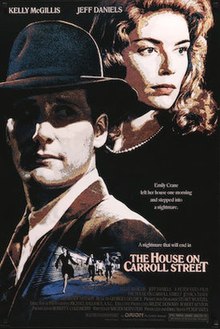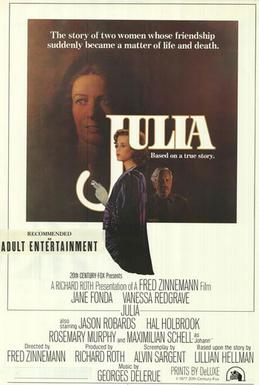
Julia is a 1977 American drama film directed by Fred Zinnemann and written by Alvin Sargent. It is based on a chapter from Lillian Hellman's 1973 book Pentimento about the author's relationship with a lifelong friend, Julia, who fought against the Nazis in the years prior to World War II. The film stars Jane Fonda as Hellman and Vanessa Redgrave as Julia. It co-stars Jason Robards, Hal Holbrook, Rosemary Murphy, Maximilian Schell, and Meryl Streep.

La Femme Nikita, also called Nikita in France, is a 1990 French-language action thriller film written and directed by Luc Besson. The film stars Anne Parillaud as the title character, a criminal who is convicted and sentenced to life imprisonment for murdering policemen during an armed pharmacy robbery. Her government handlers fake her death and recruit her as a professional assassin. After intense training, she starts a career as a killer, where she struggles to balance her work with her personal life. She shows talent at this and her career progresses until a mission in an embassy goes awry.

Kelly Ann McGillis is an American actress. She is known for her film roles such as Rachel Lapp in Witness (1985), for which she received Golden Globe and BAFTA nominations; Charlie in Top Gun (1986); Made in Heaven (1987); The House on Carroll Street (1988); and as Katheryn Murphy in The Accused (1988). In her later career, she has starred in horror films such as Stake Land (2010), The Innkeepers (2011), and We Are What We Are (2013).

Addicted to Love is a 1997 American romantic black comedy film directed by Griffin Dunne and starring Meg Ryan, Matthew Broderick, Tchéky Karyo, and Kelly Preston. Its title is based on Robert Palmer's song "Addicted to Love," a cover of the song by Neneh Cherry is featured in the film.

Six Days, Seven Nights is a 1998 American action-adventure comedy film directed by Ivan Reitman, produced by Reitman and Roger Birnbaum, and starring Harrison Ford and Anne Heche. The screenplay was written by Michael Browning. It was filmed on location in Kauai, and released on June 12, 1998. The film received mixed reviews, with praise for the performances and chemistry of Ford and Heche, but criticism of the predictable screenplay. The film was a box-office success, grossing $164.8 million worldwide.

Jackie Brown is a 1997 American crime film written and directed by Quentin Tarantino, based on the 1992 novel Rum Punch by Elmore Leonard. It stars Pam Grier as Jackie Brown, a flight attendant who smuggles money between the United States and Mexico. Samuel L. Jackson, Robert Forster, Bridget Fonda, Michael Keaton, and Robert De Niro appear in supporting roles.
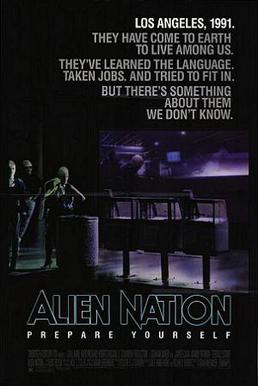
Alien Nation is a 1988 American science fiction action film written by Rockne S. O'Bannon and directed by Graham Baker. The ensemble cast features James Caan, Mandy Patinkin, and Terence Stamp. Its initial popularity inaugurated the beginning of the Alien Nation media franchise. The film depicts the assimilation of the "Newcomers", an alien race settling in Los Angeles, much to the initial dismay of the local population. The plot integrates the neo-noir and buddy cop film genres with a science fiction theme, centering on the relationship between a veteran police investigator (Caan) and an extraterrestrial (Patinkin), the first Newcomer detective. The duo probe a criminal underworld while attempting to solve a homicide. Alien Nation explores murder, discrimination and science fiction.
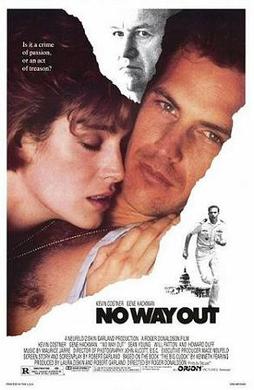
No Way Out is a 1987 American neo-noir action thriller film directed by Roger Donaldson and starring Kevin Costner, Gene Hackman, Will Patton, and Sean Young. Howard Duff, George Dzundza, Jason Bernard, Fred Thompson, and Iman appear in supporting roles. The film is based on the 1946 novel The Big Clock by Kenneth Fearing, previously filmed as The Big Clock (1948) and Police Python 357 (1976).
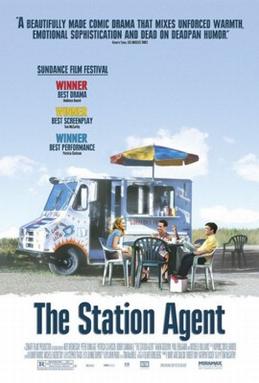
The Station Agent is a 2003 American comedy-drama film written and directed by Tom McCarthy in his directorial debut. It stars Peter Dinklage as a man who seeks solitude in an abandoned train station in the Newfoundland section of Jefferson Township, New Jersey. It also stars Patricia Clarkson, Michelle Williams, Bobby Cannavale and John Slattery. For his writing achievement, McCarthy won the BAFTA Award for Best Original Screenplay, the Independent Spirit Award for Best First Screenplay and the Waldo Salt Screenwriting Award. The film itself also won the John Cassavetes Award.
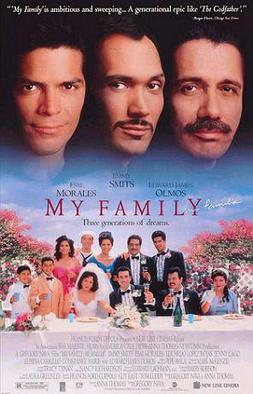
My Family is a 1995 American drama film directed by Gregory Nava, written by Nava and Anna Thomas, and starring Jimmy Smits, Edward James Olmos, and Esai Morales. The film depicts three generations of a Mexican-American family who emigrated from Mexico and settled in East Los Angeles.

52 Pick-Up is a 1986 American neo-noir crime film directed by John Frankenheimer and starring Roy Scheider, Ann-Margret, and Vanity. It is based on Elmore Leonard's 1974 novel 52 Pickup and is the second adaptation of it after The Ambassador (1984).

Romeo Is Bleeding is a 1993 neo-noir crime thriller film directed by Peter Medak, written and produced by Hilary Henkin, and starring Gary Oldman, Lena Olin, Annabella Sciorra, Juliette Lewis, and Roy Scheider. It follows a psychosexual cat-and-mouse game between a corrupt cop (Oldman), and a ruthless mob assassin (Olin) who begins to unravel his carefully constructed double life. The film's title was taken from a song by Tom Waits.

Brick is a 2005 American neo-noir mystery thriller film written and directed by Rian Johnson in his directorial debut, starring Joseph Gordon-Levitt. Brick was distributed by Focus Features, and opened in New York and Los Angeles on April 7, 2006. The film's narrative centers on a hardboiled detective story set in a California suburb. Most of the main characters are high school students. The film draws heavily in plot, characterization, and dialogue from hardboiled classics, especially those by Dashiell Hammett. The title refers to a block of heroin, compressed roughly to the size and shape of a brick.

Casa de los Babys is a 2003 drama film written, directed, and edited by filmmaker John Sayles. It features an ensemble cast, including Marcia Gay Harden, Maggie Gyllenhaal and Daryl Hannah.

Denise Calls Up is a 1995 American comedy film written and directed by Hal Salwen. It has an ensemble cast which includes Liev Schreiber, Timothy Daly, and Alanna Ubach. The plot revolves around a group of friends in New York City who, while working at their PCs and laptops and keeping in touch by phone and fax, never seem to be able to get together. The film won the Jury Prize at the Deauville American Film Festival and a Special Mention for the Camera d'Or at the Cannes Film Festival.

Ironweed is a 1987 American drama film directed by Héctor Babenco. Adapted to the screen by William Kennedy from his similarly named Pulitzer Prize–winning novel, Ironweed stars Jack Nicholson and Meryl Streep, with Carroll Baker, Michael O'Keefe, Diane Venora, Fred Gwynne, Nathan Lane, and Tom Waits in supporting roles. The story concerns the relationship of a homeless couple—Francis, an alcoholic, and Helen, a terminally ill woman—during the years following the Great Depression. Major portions of the film were shot on location in Albany, New York. The film received mixed reviews and was a box-office bomb, but Nicholson and Streep received Oscar nominations for Best Actor and Best Actress, respectively, for their performances.
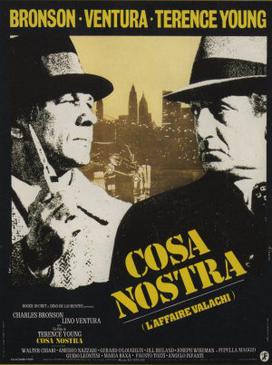
The Valachi Papers is a 1972 neo noir crime film directed by Terence Young. It is an adaptation of the 1968 non-fiction book of the same name by Peter Maas, with a screenplay by Stephen Geller. It tells the story of Joseph Valachi, a Mafia informant in the early 1960s who was the first ever government witness coming from the American Mafia itself. The film stars Charles Bronson as Valachi and Lino Ventura as crime boss Vito Genovese, with Jill Ireland, Walter Chiari, Joseph Wiseman, Gerald S. O'Loughlin, Guido Leontini, Amedeo Nazzari, Fausto Tozzi, Pupella Maggio, and Angelo Infanti.

Monsieur Hire is a 1989 French crime drama film directed by Patrice Leconte and starring Michel Blanc in the title role and Sandrine Bonnaire as the object of Hire's affection. The film received numerous accolades as well as a glowing review from the American film critic Roger Ebert, who later added the film to his list of "Great Movies." The screenplay of the film is based on the novel Les Fiançailles de M. Hire by Georges Simenon and has original music by Michael Nyman. Simenon's novel was previously filmed in 1947 by Julien Duvivier as Panic (Panique) starring Michel Simon.
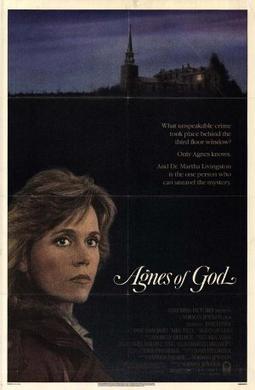
Agnes of God is a 1985 American neo-noir mystery film directed by Norman Jewison and starring Jane Fonda, Anne Bancroft and Meg Tilly. It was written by John Pielmeier, based on his 1979 play of the same name. The plot is about a novice nun (Tilly) who gives birth and insists that the dead child was the result of a virginal conception. A psychiatrist (Fonda) and the mother superior (Bancroft) of the convent clash during the resulting investigation.

Maxie is a 1985 American fantasy-comedy film directed by Paul Aaron, and starring Glenn Close, Mandy Patinkin, Valerie Curtin, Ruth Gordon and Barnard Hughes. The plot is based on the novel Marion's Wall (1973) by Jack Finney about a woman who is possessed by a very outgoing female ghost — a budding actress from the 1920s — named Maxie, who wants to fulfill her destiny.
